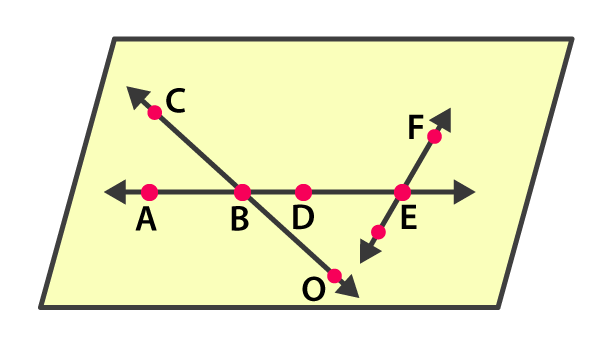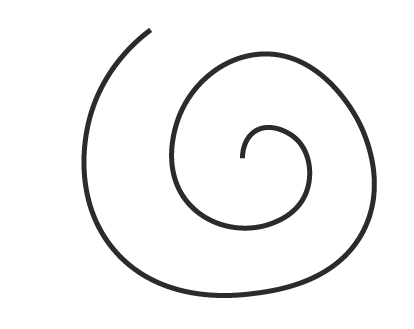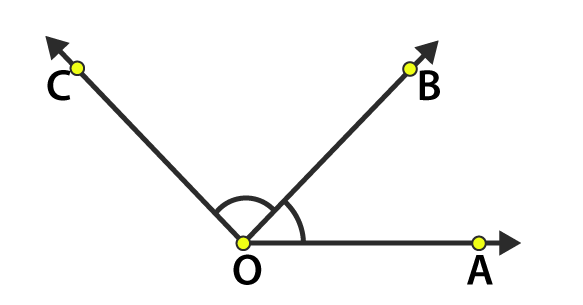Need help? We're here to assist you!
Thank You for Enquiry, we will contact you soon!
Close
The Class 6 is an important year in a student’s life and Maths is one of the subjects that require dedication, hard work, and practice. It’s a subject where you can score well if you are well-versed with the concepts, remember the important formulas and solving methods, and have done an ample amount of practice. Worry not! Home Revise is here to make your Class 6 journey even easier. It’s essential for students to have the right study material and notes to prepare for their board examinations, and through Home Revise, you can cover all the fundamental topics in the subject and the complete NCERT Class 6 Maths Book syllabus.

Exercise 4.1 Page no: 74
1. Use the figure to name:
(a) Five points
(b) A line
(c) Four rays
(d) Five line segments

Solutions:
(a) The five points are D, E, O, B and C
(b) A line is 
(c) Four rays are  ,
,  ,
,  and
and  .
.
(d) Five line segments are  ,
,  ,
,  ,
,  and
and 
2. Name the line given in all possible (twelve) ways, choosing only two letters at a time from the four given.

Solutions:
The lines are  ,
,  ,
,  ,
,  ,
,  ,
,  ,
,  ,
,  ,
,  ,
,  ,
,  ,
, 
3. Use the figure to name:
(a) Line containing point E.
(b) Line passing through A.
(c) Line on which O lies
(d) Two pairs of intersecting lines.

Solutions:
(a) Line containing point E is 
(b) Line passing through A is 
(c) Line on which O lies is 
(d) Two pairs of intersecting lines are  ,
,  and
and  ,
, 
4. How many lines can pass through (a) one given point? (b) two given points?
Solutions:
(a) Countless lines can pass through a given point.
(b) Only one line can pass through two given points.
5. Draw a rough figure and label suitably in each of the following cases:
(a) Point P lies on .
.
(b)
 and
and  intersect at M.
intersect at M.
(c) Line l contains E and F but not D.
(d)  and
and  meet at O.
meet at O.
Solutions:
(a)

(b)

(c)

(d)

6. Consider the following figure of line  . Say whether following statements are true or false in context of the given figure.
. Say whether following statements are true or false in context of the given figure.
(a) Q, M, O, N, P are points on the line  .
.
(b) M, O, N are points on a line segment .
.
(c) M and N are end points of line segment .
.
(d) O and N are end points of line segment  .
.
(e) M is one of the end points of line segment  .
.
(f) M is point on ray  .
.
(g) Ray
 is different from ray
is different from ray .
.
(h) Ray  is same as ray
is same as ray .
.
(i) Ray  is not opposite to ray
is not opposite to ray  .
.
(j) O is not an initial point of 
(k) N is the initial point of  and
and  .
.

Solutions:
(a) True
(b) True
(c) True
(d) False
(e) False
(f) False
(g) True
(h) False
(i) False
(j) False
(k) True
Exercise 4.2 Page No: 78
1. Classify the following curves as (i) Open or (ii) Closed

Solutions:
(a) The given curve is an open curve
(b) The given curve is a closed curve
(c) The given curve is an open curve
(d) The given curve is a closed curve
(e) The given curve is a closed curve
2. Draw rough diagrams to illustrate the following:
(a) Open curve
(b) Closed curve
Solutions
(a) The below figure is an open curve

(b) The below figure is a closed curve

3. Draw any polygon and shade its interior.
Solutions:
The below figure is a polygon with a shaded interior.

4. Consider the given figure and answer the questions:
(a) Is it a curve?
(b) Is it closed?

Solutions:
(a) Yes, it is a curve
(b) Yes, it is a closed curve
5. Illustrate, if possible, each one of the following with a rough diagram:
(a) A closed curve that is not a polygon.
(b) An open curve made up entirely of line segments.
(c) A polygon with two sides.
Solutions:
(a) The below figure is a closed figure but not a polygon.

(b) The below figure is an open curve made up entirely of line segments.

(c) No, it’s not possible, as the polygon with the least number of sides is a triangle, which has three sides.
Exercise 4.3 Page no: 80
1. Name the angles in the given figure.

Solutions:
The angles are ∠DAB, ∠ABC, ∠BCD and ∠CDA
2. In the given diagram, name the points(s)
(a) In the interior of ∠DOE
(b) In the exterior of ∠EOF
(c) On ∠EOF

Solutions:
(a) The point in the interior of ∠DOE is A
(b) The points in the exterior of ∠EOF is C, A and D
(c) The points on ∠EOF are E, B, O and F
3. Draw rough diagrams of two angles such that they have
(a) One point in common
(b) Two points in common
(c) Three points in common
(d) Four points in common
(e) One ray in common
Solutions:
(a) O is the common point between ∠COD and ∠AOB

(b) O and B are common points between ∠AOB and ∠BOC

(c) O, E and B are common points between ∠AOB and ∠BOC

(d) O, E, D and A are common points between ∠BOA and ∠COA

(e) OC is a common ray between ∠BOC and ∠AOC

Exercise 4.4 page no: 81
1. Draw a rough sketch of a triangle ABC. Mark a point P in its interior and a point Q in its exterior. Is the point A in its exterior or in its interior?
Solutions:
Point A lies on the given triangle ABC. It lies neither in the interior nor the exterior.

2. (a) Identify three triangles in the figure.
(b) Write the names of seven angles.
(c) Write the names of six line segments
(d) Which two triangles have ∠B as common?

Solutions:
(a) The three triangles are ∠ABD, ∠ACB, ∠ADC
(b) The angles are ∠BAC, ∠BAD, ∠CAD, ∠ADB, ∠ADC, ∠ABC, ∠ACB
(c) The line segments are  ,
,  ,
,  ,
,  ,
,  ,
, 
(d) ∠ABD and ∠ABC are triangles which have ∠B as common.
Exercise 4.5 Page no: 82
1. Draw a rough sketch of a quadrilateral PQRS. Draw its diagonals. Name them. Is the meeting point of the diagonals in the interior or exterior of the quadrilateral?
Solutions:
PR and QS are the diagonals. They meet at point O, which is in the interior of the quadrilateral.

2. Draw a rough sketch of a quadrilateral KLMN. State,
(a) two pairs of opposite sides,
(b) two pairs of opposite angles,
(c) two pairs of adjacent sides,
(d) two pairs of adjacent angles.
Solutions:

(a)
Two pairs of opposite sides are
 ,
,  and
and  ,
, 
(b) Two pairs of opposite angles are ∠KLM, ∠KNM and ∠LKN, ∠LMN
(c) Two pairs of adjacent sides are
 ,
,  and
and  ,
,  or
or  ,
,  and
and  ,
, 
(d) Two pairs of adjacent angles are ∠K, ∠L and ∠M, ∠N or ∠K, ∠L and ∠L, ∠M
Exercise 4.6 page no: 84
1. From the figure, identify:
(a) the centre of circle
(b) three radii
(c) a diameter
(d) a chord
(e) two points in the interior
(f) a point in the exterior
(g) a sector
(h) a segment

Solutions:
(a) The centre of the circle is O
(b) Three radii are  ,
,  ,
, 
(c) A diameter is 
(d) A chord is 
(e) Two points in the interior are O and P
(f) A point in the exterior is Q
(g) A sector is AOB, i.e., shaded region
(h) A segment is ED, i.e., shaded region
2. (a) Is every diameter of a circle also a chord?
(b) Is every chord of a circle also a diameter?
Solutions:
(a) Yes, every diameter of a circle is also a chord. The diameter is also called the longest chord.
(b) No, every chord is not a diameter.
3. Draw any circle and mark
(a) its centre
(b) a radius
(c) a diameter
(d) a sector
(e) a segment
(f) a point in its interior
(g) a point in its exterior
(h) an arc
Solutions:

(a) The centre of the circle is O.
(b) The radius is OC
(c) A diameter is 
(d) A sector is AOC
(e) A segment is DE
(f) A point in its interior is O
(g) A point in its exterior is F
(h) An arc is 
4. Say true or false:
(a) Two diameters of a circle will necessarily intersect.
(b) The centre of a circle is always in its interior.
Solutions:
(a) True, two diameters will always intersect each other at the centre of the circle.
(b) True, the centre of the circle will always be in its interior.
Disclaimer:
Dropped Topics – 4.11 Triangles, 4.12 Quadrilaterals, 4.13 Circles .